Covering 71,920 hectares in southern Vietnam, Cat Tien National Park is home to a number of endemic birds like the Orange-necked Partridge and Germain’s Peacock Pheasant, making it a great place for bird enthusiasts. The park is also part of a UNESCO Biosphere Reserve and including South Cat Tien, Cat Loc, and West Cat Tien. With its dense forests, wetlands, and diverse habitats, whether you’re into birdwatching or simply enjoy nature, the park offers a chance to see rare wildlife up close.
Cat Tien National Park Endemic and Highlighted Birds
Cat Tien National Park plays a crucial role in protecting bird species found only in the South Vietnamese Lowlands Endemic Bird Area (EBA). Of particular importance are the three endemic and near-endemic bird species that define this EBA: Orange-necked Partridge (Arborophila davidi), Germain’s Peacock Pheasant (Polyplectron germaini), and Grey-faced Tit Babbler (Macronous kelleyi). These species thrive in the park’s rich tropical environment, drawing birdwatchers from around the world hoping to catch a glimpse of these elusive birds.
Orange-necked Partridge
The Orange-necked Partridge is one of the crown jewels of Cat Tien National Park. Endemic to the region and classified as Near-Threatened, this elusive bird prefers dense evergreen forests, making it a challenge to spot. Its shy nature means that it is often heard before it is seen, with its distinctive call echoing through the forest understory. For birders, encountering the Orange-necked Partridge is a highlight and a rare experience.
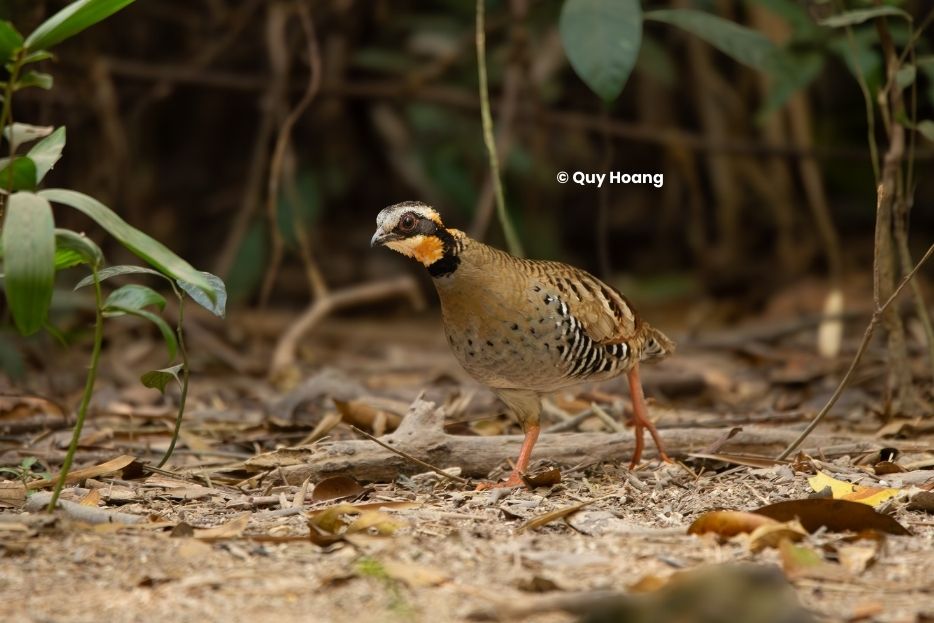
Germain’s Peacock Pheasant
Another highly sought-after bird in Cat Tien is the Germain’s Peacock Pheasant. This species is known for its magnificent fan of tail feathers adorned with striking “eye spots.” Near-endemic to Vietnam, it is typically found in the park’s lowland and secondary forests. The Germain’s Peacock Pheasant is a favorite among bird photographers for its photogenic appearance and elaborate courtship displays. Its beauty and rarity make it one of the park’s star attractions.
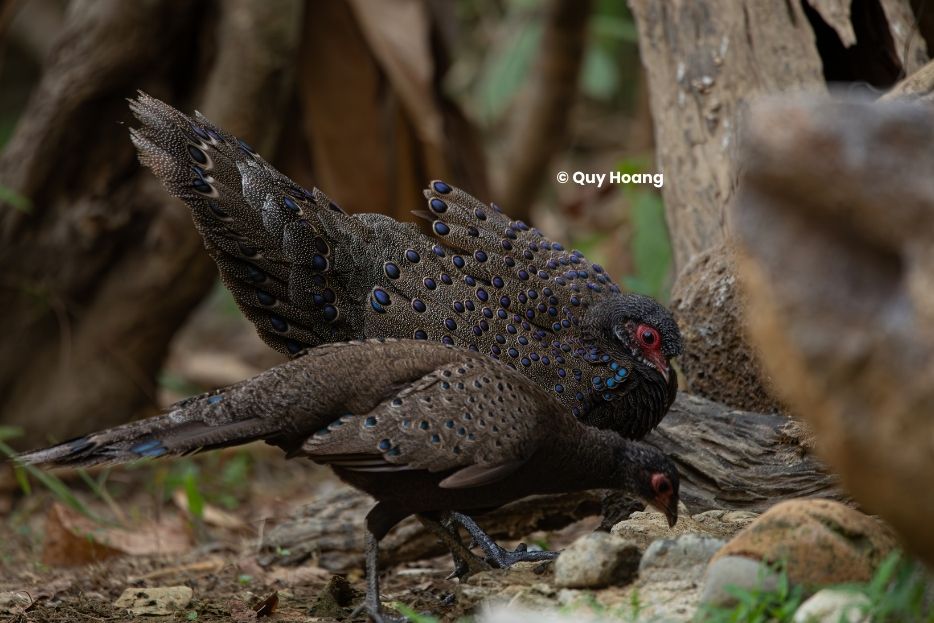
Grey-faced Tit Babbler
The Grey-faced Tit Babbler is a small, lively bird commonly found flitting through the park’s dense foliage. Known for its pale face and active behavior, this species thrives in the bamboo thickets of Cat Tien. While it is relatively common in the park, its rapid movements and preference for thick vegetation make it a challenge for birdwatchers. However, for those with patience, spotting the Grey-faced Tit Babbler is immensely rewarding.
Highlight Birds of Cat Tien National Park
While the endemic birds of Cat Tien are a major draw, the park is home to many other bird species that captivate birdwatchers and photographers alike. These include rare and endangered species, adding an extra thrill to birdwatching expeditions.
Key Bird Families in Cat Tien
Pheasants
- Orange-necked Partridge: One of the park’s key endemic species.
- Germain’s Peacock Pheasant: Known for its stunning plumage and near-endemic status.
- Siamese Fireback (Lophura diardi): A stunning pheasant often seen in the early morning along forest trails. Its vibrant colors and graceful movements make it a rewarding sight for birders.
- Green Peafowl (Pavo muticus): Endangered and one of the most majestic residents of the park, the Green Peafowl is known for its iridescent plumage. It is a must-see bird for any visitor.
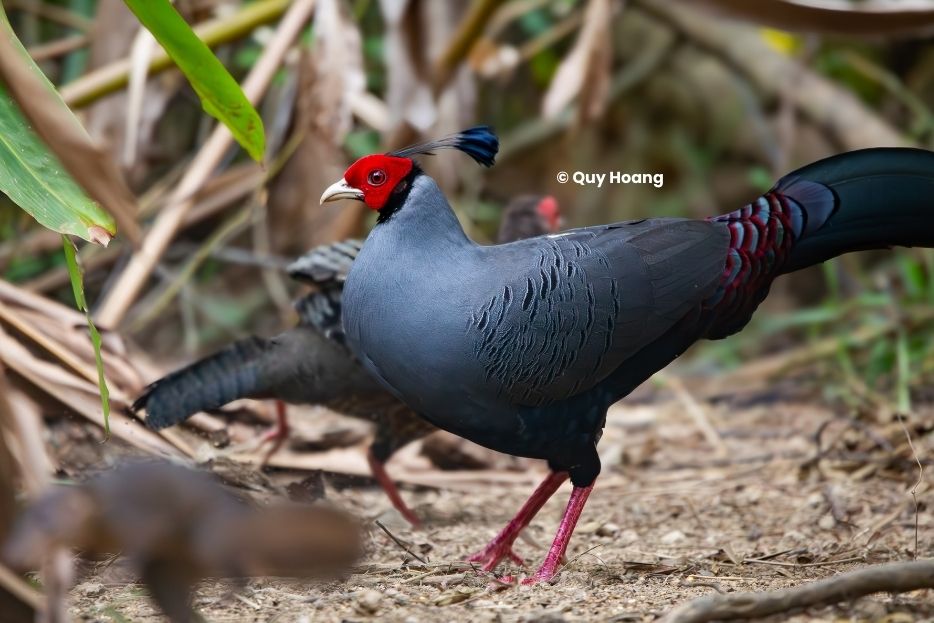
Pittas
- Bar-bellied Pitta (Hydrornis elliotii): This striking bird is known for its vibrant green and blue plumage and can often be found in the dense forest undergrowth. It is one of the highlights of many birdwatching tours.
- Blue-rumped Pitta (Hydrornis soror): Found primarily on forest floors, this bird’s colorful feathers and elusive nature make it a highly sought-after species in Cat Tien.
- Blue-winged Pitta (Pitta moluccensis): A seasonal migrant that adds further excitement to the park’s diverse bird population.
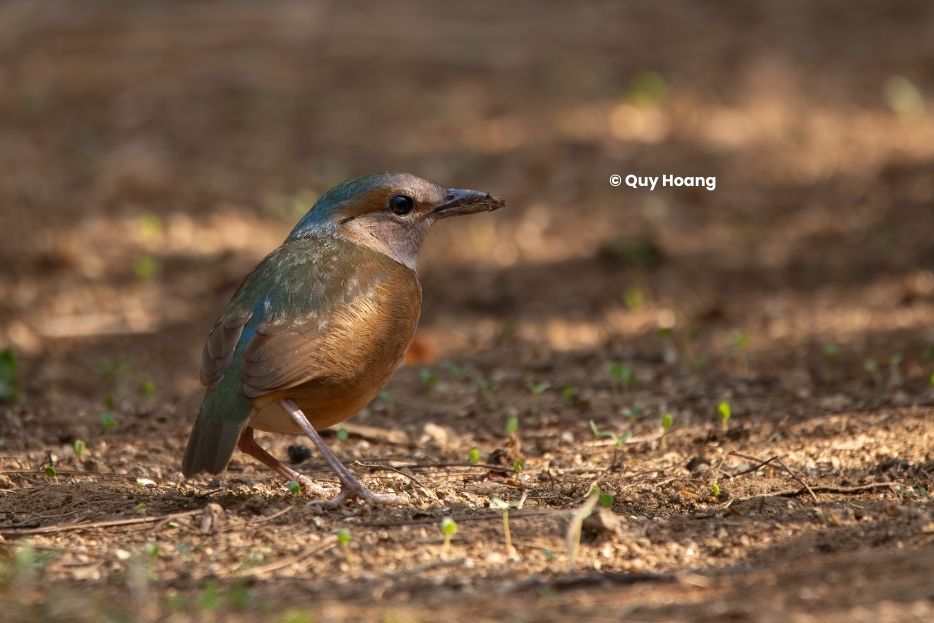
Storks
- Asian Woolly-necked Stork (Ciconia episcopus): Listed as Near-Threatened, this stately bird can often be seen wading through the park’s wetlands. Its presence in the park is a testament to Cat Tien’s thriving ecosystem.
- Lesser Adjutant Stork (Leptoptilos javanicus): Another highlight for birdwatchers, this Vulnerable species is frequently found in the park’s marshy areas.
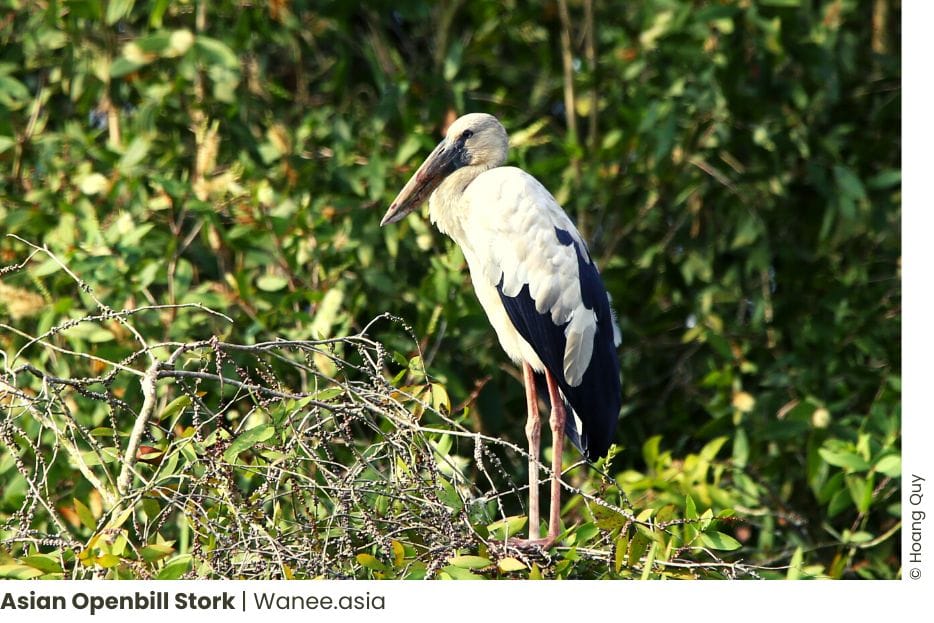
Kingfishers
- Banded Kingfisher (Lacedo pulchella): Known for its striking blue and black plumage, the Banded Kingfisher is a favorite among bird photographers and is often seen perched along water bodies in the park.
- Black-backed Dwarf Kingfisher (Ceyx erithaca): Despite its small size, this colorful kingfisher is a delightful sight for birdwatchers, frequently seen darting over streams and ponds.
- Stork-billed Kingfisher (Pelargopsis capensis): With its large bill and vibrant colors, this kingfisher stands out among Cat Tien’s avian residents.
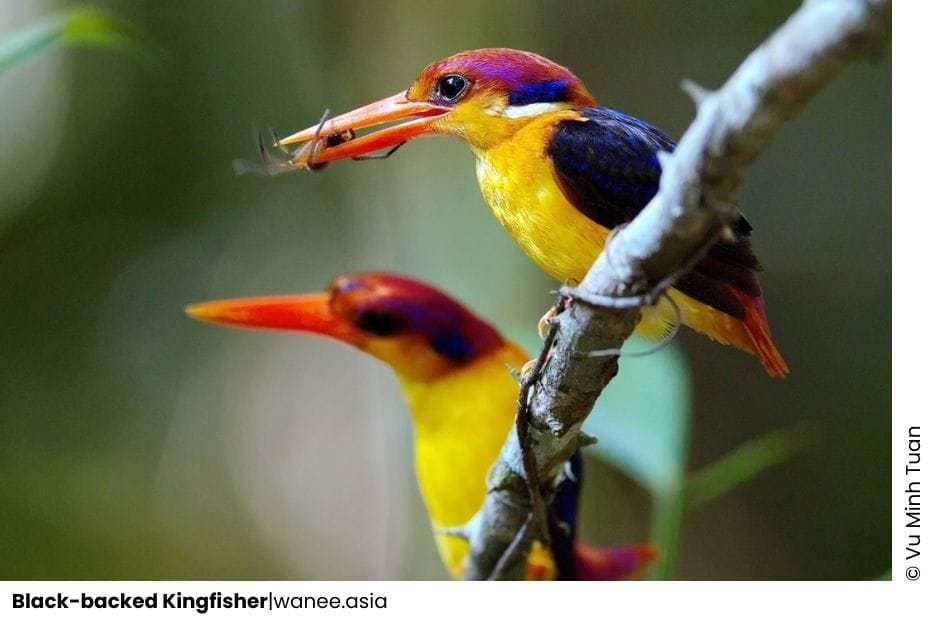
Broadbills
- Banded Broadbill (Eurylaimus javanicus): With its striking plumage and large bill, this bird is often found in the park’s lower canopy. Its unique appearance makes it a favorite for birders.
- Black-and-red Broadbill (Cymbirhynchus macrorhynchos): Known for its vivid coloration, this species is easily recognizable and frequently seen in mixed-species flocks.
- Dusky Broadbill (Corydon sumatranus): A more elusive member of the broadbill family, the Dusky Broadbill adds a layer of intrigue to any birdwatching expedition.
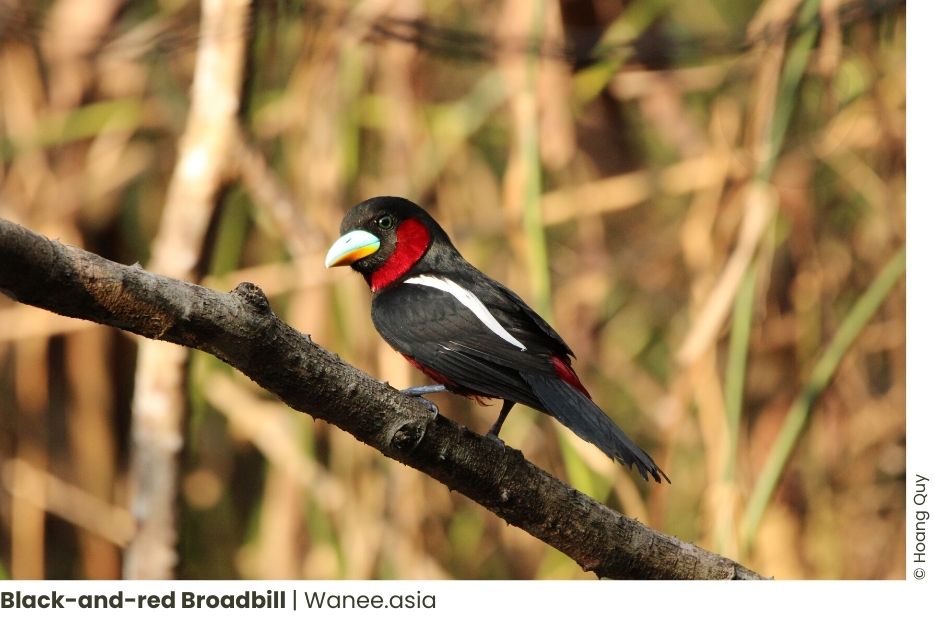
Woodpeckers
- Black-and-buff Woodpecker (Meiglyptes jugularis): A rare woodpecker species that inhabits the lowland forests of Cat Tien.
- Great Slaty Woodpecker (Mulleripicus pulverulentus): The largest of all woodpeckers, this bird is a thrilling sight for birdwatchers due to its impressive size and powerful drumming.
- Pale-headed Woodpecker (Gecinulus grantia): This bird’s pale plumage sets it apart from the other woodpeckers, making it a standout species in the dense forests.
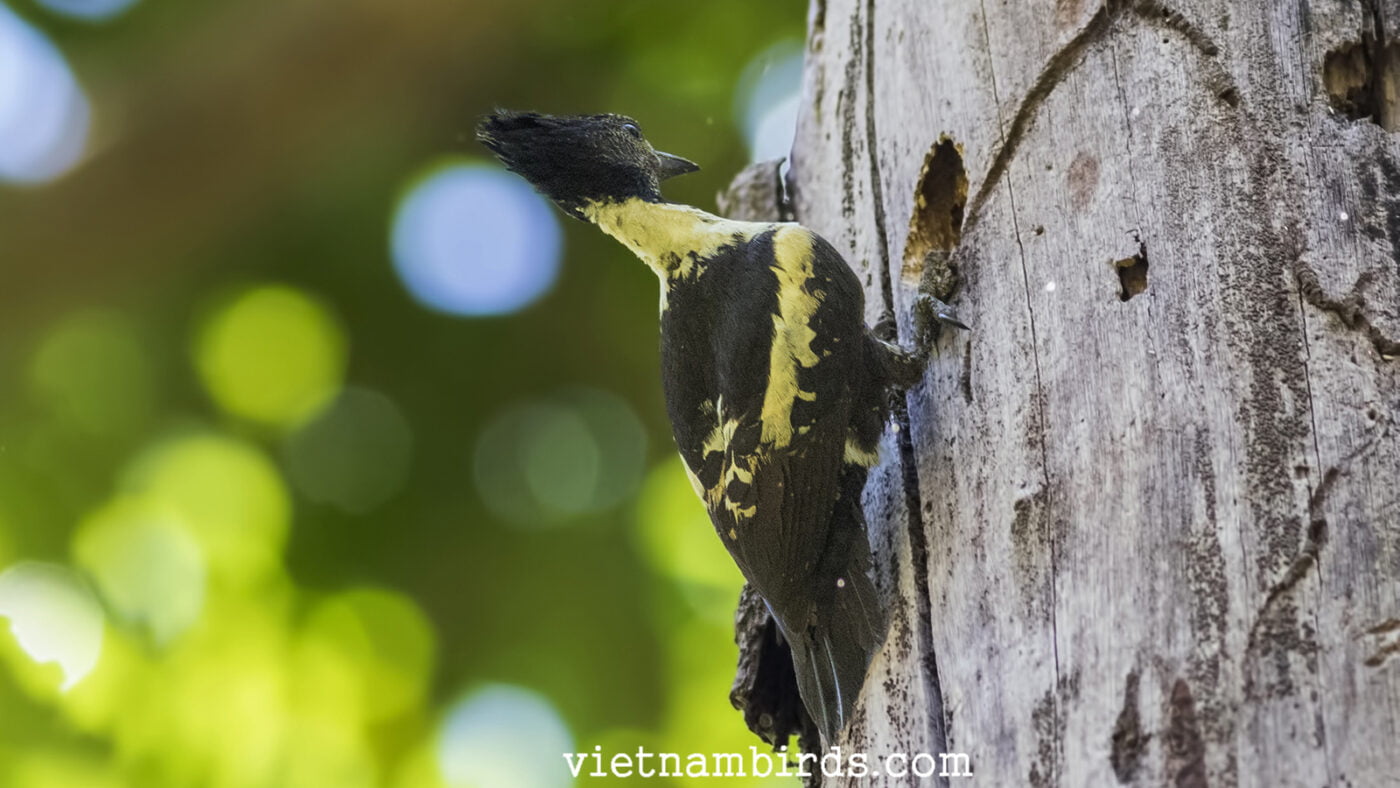
Bird list in Cat Tien
Number of species: 379 – Avibase
Number of globally threatened species: 11 – IUCN
Number of introduced species: 1
| No. | English Name | Latin Name | Status |
| ANSERIFORMES: Anatidae | |||
| 1 | Lesser Whistling-Duck | Dendrocygna javanica | |
| 2 | Cotton Pygmy-Goose | Nettapus coromandelianus | |
| 3 | White-winged Duck | Asarcornis scutulata | Endangered |
| GALLIFORMES: Phasianidae | |||
| 4 | Bar-backed Partridge | Arborophila brunneopectus | |
| 5 | Orange-necked Partridge | Arborophila davidi | Endemic (country/region) Near-threatened |
| 6 | Siamese Fireback | Lophura diardi | |
| 7 | Green Peafowl | Pavo muticus | Endangered |
| 8 | Scaly-breasted Partridge | Tropicoperdix chloropus | |
| 9 | Germain’s Peacock-Pheasant | Polyplectron germaini | Endemic (country/region) Near-threatened |
| 10 | Red Junglefowl | Gallus gallus | |
| 11 | Chinese Francolin | Francolinus pintadeanus | |
| 12 | Blue-breasted Quail | Synoicus chinensis | |
| PODICIPEDIFORMES: Podicipedidae | |||
| 13 | Little Grebe | Tachybaptus ruficollis | |
| COLUMBIFORMES: Columbidae | |||
| 14 | Oriental Turtle-Dove | Streptopelia orientalis | |
| 15 | Red Collared-Dove | Streptopelia tranquebarica | |
| 16 | Spotted Dove | Spilopelia chinensis | |
| 17 | Barred Cuckoo-Dove | Macropygia unchall | |
| 18 | Asian Emerald Dove | Chalcophaps indica | |
| 19 | Zebra Dove | Geopelia striata | Rare/Accidental |
| 20 | Pink-necked Green-Pigeon | Treron vernans | |
| 21 | Orange-breasted Green-Pigeon | Treron bicinctus | |
| 22 | Ashy-headed Green-Pigeon | Treron phayrei | Near-threatened |
| 23 | Thick-billed Green-Pigeon | Treron curvirostra | |
| 24 | Yellow-footed Green-Pigeon | Treron phoenicopterus | |
| 25 | Yellow-vented Green-Pigeon | Treron seimundi | |
| 26 | Pin-tailed Green-Pigeon | Treron apicauda | |
| 27 | Wedge-tailed Green-Pigeon | Treron sphenurus | |
| 28 | Green Imperial-Pigeon | Ducula aenea | Near-threatened |
| CUCULIFORMES: Cuculidae | |||
| 29 | Greater Coucal | Centropus sinensis | |
| 30 | Lesser Coucal | Centropus bengalensis | |
| 31 | Green-billed Malkoha | Phaenicophaeus tristis | |
| 32 | Chestnut-winged Cuckoo | Clamator coromandus | |
| 33 | Asian Koel | Eudynamys scolopaceus | |
| 34 | Asian Emerald Cuckoo | Chrysococcyx maculatus | |
| 35 | Violet Cuckoo | Chrysococcyx xanthorhynchus | |
| 36 | Little Bronze-Cuckoo | Chrysococcyx minutillus | |
| 37 | Banded Bay Cuckoo | Cacomantis sonneratii | |
| 38 | Plaintive Cuckoo | Cacomantis merulinus | |
| 39 | Square-tailed Drongo-Cuckoo | Surniculus lugubris | |
| 40 | Large Hawk-Cuckoo | Hierococcyx sparverioides | |
| 41 | Hodgson’s Hawk-Cuckoo | Hierococcyx nisicolor | |
| 42 | Indian Cuckoo | Cuculus micropterus | |
| CAPRIMULGIFORMES: Podargidae | |||
| 43 | Blyth’s Frogmouth | Batrachostomus affinis | |
| CAPRIMULGIFORMES: Caprimulgidae | |||
| 44 | Great Eared-Nightjar | Lyncornis macrotis | |
| 45 | Gray Nightjar | Caprimulgus jotaka | |
| 46 | Large-tailed Nightjar | Caprimulgus macrurus | |
| CAPRIMULGIFORMES: Apodidae | |||
| 47 | Silver-backed Needletail | Hirundapus cochinchinensis | |
| 48 | Brown-backed Needletail | Hirundapus giganteus | |
| 49 | Himalayan Swiftlet | Aerodramus brevirostris | |
| 50 | Germain’s Swiftlet | Aerodramus germani | |
| 51 | Pacific Swift | Apus pacificus | |
| 52 | House Swift | Apus nipalensis | |
| 53 | Asian Palm Swift | Cypsiurus balasiensis | |
| CAPRIMULGIFORMES: Hemiprocnidae | |||
| 54 | Crested Treeswift | Hemiprocne coronata | |
| GRUIFORMES: Rallidae | |||
| 55 | Slaty-breasted Rail | Lewinia striata | |
| 56 | Eurasian Moorhen | Gallinula chloropus | |
| 57 | Eurasian Coot | Fulica atra | |
| 58 | Gray-headed Swamphen | Porphyrio poliocephalus | |
| 59 | White-browed Crake | Poliolimnas cinereus | |
| 60 | Watercock | Gallicrex cinerea | |
| 61 | White-breasted Waterhen | Amaurornis phoenicurus | |
| 62 | Red-legged Crake | Rallina fasciata | |
| 63 | Slaty-legged Crake | Rallina eurizonoides | |
| 64 | Ruddy-breasted Crake | Zapornia fusca | |
| 65 | Baillon’s Crake | Zapornia pusilla | |
| CHARADRIIFORMES: Recurvirostridae | |||
| 66 | Black-winged Stilt | Himantopus himantopus | |
| CHARADRIIFORMES: Charadriidae | |||
| 67 | River Lapwing | Vanellus duvaucelii | Near-threatened |
| 68 | Gray-headed Lapwing | Vanellus cinereus | |
| 69 | Red-wattled Lapwing | Vanellus indicus | |
| 70 | Kentish Plover | Charadrius alexandrinus | |
| 71 | Little Ringed Plover | Charadrius dubius | |
| CHARADRIIFORMES: Rostratulidae | |||
| 72 | Greater Painted-Snipe | Rostratula benghalensis | |
| CHARADRIIFORMES: Jacanidae | |||
| 73 | Pheasant-tailed Jacana | Hydrophasianus chirurgus | |
| 74 | Bronze-winged Jacana | Metopidius indicus | |
| CHARADRIIFORMES: Scolopacidae | |||
| 75 | Ruff | Calidris pugnax | |
| 76 | Common Snipe | Gallinago gallinago | |
| 77 | Pin-tailed Snipe | Gallinago stenura | |
| 78 | Common Sandpiper | Actitis hypoleucos | |
| 79 | Green Sandpiper | Tringa ochropus | |
| 80 | Spotted Redshank | Tringa erythropus | |
| 81 | Common Greenshank | Tringa nebularia | |
| 82 | Marsh Sandpiper | Tringa stagnatilis | |
| 83 | Wood Sandpiper | Tringa glareola | |
| 84 | Common Redshank | Tringa totanus | |
| CHARADRIIFORMES: Turnicidae | |||
| 85 | Yellow-legged Buttonquail | Turnix tanki | |
| 86 | Barred Buttonquail | Turnix suscitator | |
| CHARADRIIFORMES: Glareolidae | |||
| 87 | Oriental Pratincole | Glareola maldivarum | |
| CHARADRIIFORMES: Laridae | |||
| 88 | Whiskered Tern | Chlidonias hybrida | |
| CICONIIFORMES: Ciconiidae | |||
| 89 | Asian Openbill | Anastomus oscitans | |
| 90 | Asian Woolly-necked Stork | Ciconia episcopus | Near-threatened |
| 91 | Lesser Adjutant | Leptoptilos javanicus | Vulnerable |
| 92 | Painted Stork | Mycteria leucocephala | Near-threatened |
| SULIFORMES: Anhingidae | |||
| 93 | Oriental Darter | Anhinga melanogaster | Near-threatened |
| SULIFORMES: Phalacrocoracidae | |||
| 94 | Little Cormorant | Microcarbo niger | |
| 95 | Indian Cormorant | Phalacrocorax fuscicollis | |
| PELECANIFORMES: Ardeidae | |||
| 96 | Yellow Bittern | Ixobrychus sinensis | |
| 97 | Cinnamon Bittern | Ixobrychus cinnamomeus | |
| 98 | Black Bittern | Ixobrychus flavicollis | |
| 99 | Gray Heron | Ardea cinerea | |
| 100 | Purple Heron | Ardea purpurea | |
| 101 | Great Egret | Ardea alba | |
| 102 | Intermediate Egret | Ardea intermedia | |
| 103 | Little Egret | Egretta garzetta | |
| 104 | Cattle Egret | Bubulcus ibis | |
| 105 | Chinese Pond-Heron | Ardeola bacchus | |
| 106 | Javan Pond-Heron | Ardeola speciosa | |
| 107 | Striated Heron | Butorides striata | |
| 108 | Black-crowned Night-Heron | Nycticorax nycticorax | |
| 109 | Malayan Night-Heron | Gorsachius melanolophus | |
| PELECANIFORMES: Threskiornithidae | |||
| 110 | White-shouldered Ibis | Pseudibis davisoni | Critically endangered |
| ACCIPITRIFORMES: Pandionidae | |||
| 111 | Osprey | Pandion haliaetus | |
| ACCIPITRIFORMES: Accipitridae | |||
| 112 | Black-winged Kite | Elanus caeruleus | |
| 113 | Oriental Honey-buzzard | Pernis ptilorhynchus | |
| 114 | Jerdon’s Baza | Aviceda jerdoni | |
| 115 | Black Baza | Aviceda leuphotes | |
| 116 | Crested Serpent-Eagle | Spilornis cheela | |
| 117 | Mountain Hawk-Eagle | Nisaetus nipalensis | |
| 118 | Changeable Hawk-Eagle | Nisaetus cirrhatus | |
| 119 | Rufous-bellied Eagle | Lophotriorchis kienerii | Near-threatened |
| 120 | Black Eagle | Ictinaetus malaiensis | |
| 121 | Gray-faced Buzzard | Butastur indicus | |
| 122 | Eastern Marsh-Harrier | Circus spilonotus | |
| 123 | Pied Harrier | Circus melanoleucos | |
| 124 | Crested Goshawk | Accipiter trivirgatus | |
| 125 | Shikra | Accipiter badius | |
| 126 | Black Kite | Milvus migrans | |
| 127 | Brahminy Kite | Haliastur indus | |
| 128 | White-bellied Sea-Eagle | Haliaeetus leucogaster | |
| 129 | Lesser Fish-Eagle | Haliaeetus humilis | Near-threatened |
| 130 | Gray-headed Fish-Eagle | Haliaeetus ichthyaetus | Near-threatened |
| 131 | Eastern Buzzard | Buteo japonicus | |
| STRIGIFORMES: Tytonidae | |||
| 132 | Barn Owl | Tyto alba | |
| 133 | Oriental Bay-Owl | Phodilus badius | |
| STRIGIFORMES: Strigidae | |||
| 134 | Mountain Scops-Owl | Otus spilocephalus | |
| 135 | Collared Scops-Owl | Otus lettia | |
| 136 | Oriental Scops-Owl | Otus sunia | |
| 137 | Buffy Fish-Owl | Ketupa ketupu | |
| 138 | Brown Fish-Owl | Ketupa zeylonensis | |
| 139 | Tawny Fish-Owl | Ketupa flavipes | |
| 140 | Spot-bellied Eagle-Owl | Ketupa nipalensis | |
| 141 | Asian Barred Owlet | Glaucidium cuculoides | |
| 142 | Collared Owlet | Taenioptynx brodiei | |
| 143 | Brown Boobook | Ninox scutulata | |
| TROGONIFORMES: Trogonidae | |||
| 144 | Red-headed Trogon | Harpactes erythrocephalus | |
| 145 | Orange-breasted Trogon | Harpactes oreskios | |
| BUCEROTIFORMES: Upupidae | |||
| 146 | Eurasian Hoopoe | Upupa epops | |
| BUCEROTIFORMES: Bucerotidae | |||
| 147 | Great Hornbill | Buceros bicornis | Vulnerable |
| 148 | Oriental Pied-Hornbill | Anthracoceros albirostris | |
| 149 | Wreathed Hornbill | Rhyticeros undulatus | Vulnerable |
| CORACIIFORMES: Alcedinidae | |||
| 150 | Common Kingfisher | Alcedo atthis | |
| 151 | Blue-eared Kingfisher | Alcedo meninting | |
| 152 | Black-backed Dwarf-Kingfisher | Ceyx erithaca | |
| 153 | Banded Kingfisher | Lacedo pulchella | |
| 154 | Stork-billed Kingfisher | Pelargopsis capensis | |
| 155 | Ruddy Kingfisher | Halcyon coromanda | |
| 156 | White-throated Kingfisher | Halcyon smyrnensis | |
| 157 | Black-capped Kingfisher | Halcyon pileata | Vulnerable |
| 158 | Collared Kingfisher | Todiramphus chloris | |
| 159 | Pied Kingfisher | Ceryle rudis | |
| CORACIIFORMES: Meropidae | |||
| 160 | Blue-bearded Bee-eater | Nyctyornis athertoni | |
| 161 | Asian Green Bee-eater | Merops orientalis | |
| 162 | Blue-tailed Bee-eater | Merops philippinus | |
| 163 | Chestnut-headed Bee-eater | Merops leschenaulti | |
| CORACIIFORMES: Coraciidae | |||
| 164 | Indochinese Roller | Coracias affinis | |
| 165 | Dollarbird | Eurystomus orientalis | |
| PICIFORMES: Megalaimidae | |||
| 166 | Coppersmith Barbet | Psilopogon haemacephalus | |
| 167 | Blue-eared Barbet | Psilopogon duvaucelii | |
| 168 | Red-vented Barbet | Psilopogon lagrandieri | |
| 169 | Green-eared Barbet | Psilopogon faiostrictus | |
| 170 | Lineated Barbet | Psilopogon lineatus | |
| PICIFORMES: Picidae | |||
| 171 | Speckled Piculet | Picumnus innominatus | |
| 172 | White-browed Piculet | Sasia ochracea | |
| 173 | Heart-spotted Woodpecker | Hemicircus canente | |
| 174 | Gray-capped Pygmy Woodpecker | Yungipicus canicapillus | |
| 175 | Bay Woodpecker | Blythipicus pyrrhotis | |
| 176 | Greater Flameback | Chrysocolaptes guttacristatus | |
| 177 | Rufous Woodpecker | Micropternus brachyurus | |
| 178 | Black-and-buff Woodpecker | Meiglyptes jugularis | |
| 179 | Pale-headed Woodpecker | Gecinulus grantia | |
| 180 | Common Flameback | Dinopium javanense | |
| 181 | Lesser Yellownape | Picus chlorolophus | |
| 182 | Laced Woodpecker | Picus vittatus | |
| 183 | Gray-headed Woodpecker | Picus canus | |
| 184 | Greater Yellownape | Chrysophlegma flavinucha | |
| 185 | Great Slaty Woodpecker | Mulleripicus pulverulentus | Vulnerable |
| 186 | White-bellied Woodpecker | Dryocopus javensis | |
| FALCONIFORMES: Falconidae | |||
| 187 | Collared Falconet | Microhierax caerulescens | |
| 188 | Eurasian Kestrel | Falco tinnunculus | |
| 189 | Oriental Hobby | Falco severus | |
| 190 | Peregrine Falcon | Falco peregrinus | |
| PSITTACIFORMES: Psittaculidae | |||
| 191 | Alexandrine Parakeet | Psittacula eupatria | Near-threatened |
| 192 | Gray-headed Parakeet | Psittacula finschii | Near-threatened |
| 193 | Blossom-headed Parakeet | Psittacula roseata | Near-threatened |
| 194 | Red-breasted Parakeet | Psittacula alexandri | Near-threatened |
| 195 | Vernal Hanging-Parrot | Loriculus vernalis | |
| PASSERIFORMES: Eurylaimidae | |||
| 196 | Dusky Broadbill | Corydon sumatranus | |
| 197 | Black-and-red Broadbill | Cymbirhynchus macrorhynchos | |
| 198 | Banded Broadbill | Eurylaimus javanicus | |
| PASSERIFORMES: Pittidae | |||
| 199 | Blue-rumped Pitta | Hydrornis soror | |
| 200 | Bar-bellied Pitta | Hydrornis elliotii | |
| 201 | Blue-winged Pitta | Pitta moluccensis | |
| 202 | Fairy Pitta | Pitta nympha | Vulnerable |
| PASSERIFORMES: Campephagidae | |||
| 203 | Small Minivet | Pericrocotus cinnamomeus | |
| 204 | Scarlet Minivet | Pericrocotus speciosus | |
| 205 | Ashy Minivet | Pericrocotus divaricatus | |
| 206 | Brown-rumped Minivet | Pericrocotus cantonensis | |
| 207 | Rosy Minivet | Pericrocotus roseus | |
| 208 | Large Cuckooshrike | Coracina macei | |
| 209 | Black-winged Cuckooshrike | Lalage melaschistos | |
| 210 | Indochinese Cuckooshrike | Lalage polioptera | |
| PASSERIFORMES: Vireonidae | |||
| 211 | White-bellied Erpornis | Erpornis zantholeuca | |
| PASSERIFORMES: Oriolidae | |||
| 212 | Black-naped Oriole | Oriolus chinensis | |
| 213 | Black-hooded Oriole | Oriolus xanthornus | |
| 214 | Maroon Oriole | Oriolus traillii | |
| PASSERIFORMES: Artamidae | |||
| 215 | Ashy Woodswallow | Artamus fuscus | |
| PASSERIFORMES: Vangidae | |||
| 216 | Large Woodshrike | Tephrodornis virgatus | |
| 217 | Common Woodshrike | Tephrodornis pondicerianus | |
| 218 | Bar-winged Flycatcher-shrike | Hemipus picatus | |
| PASSERIFORMES: Aegithinidae | |||
| 219 | Common Iora | Aegithina tiphia | |
| 230 | Great Iora | Aegithina lafresnayei | |
| PASSERIFORMES: Rhipiduridae | |||
| 231 | Malaysian Pied-Fantail | Rhipidura javanica | |
| PASSERIFORMES: Dicruridae | |||
| 232 | Black Drongo | Dicrurus macrocercus | |
| 233 | Ashy Drongo | Dicrurus leucophaeus | |
| 234 | Crow-billed Drongo | Dicrurus annectens | |
| 235 | Bronzed Drongo | Dicrurus aeneus | |
| 236 | Lesser Racket-tailed Drongo | Dicrurus remifer | |
| 237 | Hair-crested Drongo | Dicrurus hottentottus | |
| 238 | Greater Racket-tailed Drongo | Dicrurus paradiseus | |
| PASSERIFORMES: Monarchidae | |||
| 239 | Black-naped Monarch | Hypothymis azurea | |
| 240 | Blyth’s Paradise-Flycatcher | Terpsiphone affinis | |
| PASSERIFORMES: Laniidae | |||
| 241 | Tiger Shrike | Lanius tigrinus | |
| 242 | Brown Shrike | Lanius cristatus | |
| 243 | Burmese Shrike | Lanius collurioides | |
| PASSERIFORMES: Corvidae | |||
| 244 | Indochinese Green-Magpie | Cissa hypoleuca | |
| 245 | Racket-tailed Treepie | Crypsirina temia | |
| 246 | Large-billed Crow | Corvus macrorhynchos | |
| PASSERIFORMES: Stenostiridae | |||
| 247 | Gray-headed Canary-Flycatcher | Culicicapa ceylonensis | |
| PASSERIFORMES: Alaudidae | |||
| 248 | Indochinese Bushlark | Mirafra erythrocephala | |
| 249 | Oriental Skylark | Alauda gulgula | |
| PASSERIFORMES: Cisticolidae | |||
| 250 | Common Tailorbird | Orthotomus sutorius | |
| 251 | Dark-necked Tailorbird | Orthotomus atrogularis | |
| 252 | Rufescent Prinia | Prinia rufescens | |
| 253 | Gray-breasted Prinia | Prinia hodgsonii | |
| 254 | Yellow-bellied Prinia | Prinia flaviventris | |
| 255 | Plain Prinia | Prinia inornata | |
| 256 | Zitting Cisticola | Cisticola juncidis | |
| 257 | Golden-headed Cisticola | Cisticola exilis | |
| PASSERIFORMES: Acrocephalidae | |||
| 258 | Thick-billed Warbler | Arundinax aedon | |
| 259 | Black-browed Reed Warbler | Acrocephalus bistrigiceps | |
| 260 | Blunt-winged Warbler | Acrocephalus concinens | |
| 261 | Manchurian Reed Warbler | Acrocephalus tangorum | Vulnerable |
| 262 | Oriental Reed Warbler | Acrocephalus orientalis | |
| PASSERIFORMES: Locustellidae | |||
| 263 | Pallas’s Grasshopper Warbler | Helopsaltes certhiola | |
| 264 | Lanceolated Warbler | Locustella lanceolata | |
| 265 | Striated Grassbird | Cincloramphus palustris | |
| PASSERIFORMES: Hirundinidae | |||
| 266 | Bank Swallow | Riparia riparia | |
| 267 | Dusky Crag-Martin | Ptyonoprogne concolor | |
| 268 | Barn Swallow | Hirundo rustica | |
| 269 | Pacific Swallow | Hirundo tahitica | |
| 270 | Red-rumped Swallow | Cecropis daurica | |
| 271 | Striated Swallow | Cecropis striolata | |
| 272 | Common House-Martin | Delichon urbicum | |
| 273 | Asian House-Martin | Delichon dasypus | |
| PASSERIFORMES: Pycnonotidae | |||
| 274 | Black-headed Bulbul | Brachypodius melanocephalos | |
| 275 | Black-crested Bulbul | Rubigula flaviventris | |
| 276 | Red-whiskered Bulbul | Pycnonotus jocosus | |
| 277 | Sooty-headed Bulbul | Pycnonotus aurigaster | |
| 278 | Stripe-throated Bulbul | Pycnonotus finlaysoni | |
| 279 | Yellow-vented Bulbul | Pycnonotus goiavier | |
| 280 | Streak-eared Bulbul | Pycnonotus conradi | |
| 281 | Ochraceous Bulbul | Alophoixus ochraceus | |
| 282 | Gray-eyed Bulbul | Iole propinqua | |
| 283 | Black Bulbul | Hypsipetes leucocephalus | |
| PASSERIFORMES: Phylloscopidae | |||
| 284 | Yellow-browed Warbler | Phylloscopus inornatus | |
| 285 | Radde’s Warbler | Phylloscopus schwarzi | |
| 286 | Dusky Warbler | Phylloscopus fuscatus | |
| 287 | Eastern Crowned Warbler | Phylloscopus coronatus | |
| 288 | Alström’s Warbler | Phylloscopus soror | |
| 289 | Two-barred Warbler | Phylloscopus plumbeitarsus | |
| 290 | Pale-legged Leaf Warbler | Phylloscopus tenellipes | |
| 291 | Arctic Warbler | Phylloscopus borealis | |
| PASSERIFORMES: Scotocercidae | |||
| 292 | Yellow-bellied Warbler | Abroscopus superciliaris | |
| PASSERIFORMES: Sylviidae | |||
| 293 | Yellow-eyed Babbler | Chrysomma sinense | |
| PASSERIFORMES: Zosteropidae | |||
| 294 | Indian White-eye | Zosterops palpebrosus | |
| PASSERIFORMES: Timaliidae | |||
| 295 | Chestnut-capped Babbler | Timalia pileata | |
| 296 | Gray-faced Tit-Babbler | Mixornis kelleyi | |
| 297 | Pin-striped Tit-Babbler | Mixornis gularis | |
| 298 | White-browed Scimitar-Babbler | Pomatorhinus schisticeps | |
| 299 | Large Scimitar-Babbler | Erythrogenys hypoleucos | |
| 300 | Gray-throated Babbler | Stachyris nigriceps | |
| PASSERIFORMES: Pellorneidae | |||
| 301 | Scaly-crowned Babbler | Malacopteron cinereum | |
| 302 | Collared Babbler | Gampsorhynchus torquatus | |
| 303 | Puff-throated Babbler | Pellorneum ruficeps | |
| 304 | Buff-breasted Babbler | Pellorneum tickelli | |
| 305 | Abbott’s Babbler | Malacocincla abbotti | |
| PASSERIFORMES: Leiothrichidae | |||
| 306 | Black-browed Fulvetta | Alcippe grotei | |
| 307 | Lesser Necklaced Laughingthrush | Garrulax monileger | |
| 308 | White-crested Laughingthrush | Garrulax leucolophus | |
| 309 | Black-throated Laughingthrush | Pterorhinus chinensis | |
| PASSERIFORMES: Sittidae | |||
| 310 | Velvet-fronted Nuthatch | Sitta frontalis | |
| PASSERIFORMES: Sturnidae | |||
| 311 | Golden-crested Myna | Ampeliceps coronatus | |
| 312 | Common Hill Myna | Gracula religiosa | |
| 313 | Black-collared Starling | Gracupica nigricollis | |
| 314 | White-shouldered Starling | Sturnia sinensis | |
| 315 | Chestnut-tailed Starling | Sturnia malabarica | |
| 316 | Common Myna | Acridotheres tristis | |
| 317 | Vinous-breasted Myna | Acridotheres leucocephalus | |
| 318 | Great Myna | Acridotheres grandis | |
| PASSERIFORMES: Turdidae | |||
| 319 | White’s Thrush | Zoothera aurea | |
| 320 | Siberian Thrush | Geokichla sibirica | |
| 321 | Orange-headed Thrush | Geokichla citrina | |
| 322 | Japanese Thrush | Turdus cardis | |
| 323 | Black-breasted Thrush | Turdus dissimilis | |
| 324 | Eyebrowed Thrush | Turdus obscurus | |
| PASSERIFORMES: Muscicapidae | |||
| 325 | Dark-sided Flycatcher | Muscicapa sibirica | |
| 326 | Asian Brown Flycatcher | Muscicapa dauurica | |
| 327 | Oriental Magpie-Robin | Copsychus saularis | |
| 328 | White-rumped Shama | Copsychus malabaricus | |
| 329 | Hainan Blue Flycatcher | Cyornis hainanus | |
| 330 | Indochinese Blue Flycatcher | Cyornis sumatrensis | |
| 331 | Blue-and-white Flycatcher | Cyanoptila cyanomelana | |
| 332 | Zappey’s Flycatcher | Cyanoptila cumatilis | Rare/Accidental Near-threatened |
| 333 | Verditer Flycatcher | Eumyias thalassinus | |
| 334 | Rufous-tailed Robin | Larvivora sibilans | |
| 335 | Siberian Blue Robin | Larvivora cyane | |
| 336 | Bluethroat | Luscinia svecica | |
| 337 | Blue Whistling-Thrush | Myophonus caeruleus | |
| 338 | Siberian Rubythroat | Calliope calliope | |
| 339 | Yellow-rumped Flycatcher | Ficedula zanthopygia | |
| 340 | Narcissus Flycatcher | Ficedula narcissina | Rare/Accidental |
| 341 | Taiga Flycatcher | Ficedula albicilla | |
| 342 | White-throated Rock-Thrush | Monticola gularis | |
| 343 | Blue Rock-Thrush | Monticola solitarius | |
| 344 | Amur Stonechat | Saxicola stejnegeri | |
| 345 | Pied Bushchat | Saxicola caprata | |
| 346 | Gray Bushchat | Saxicola ferreus | |
| PASSERIFORMES: Dicaeidae | |||
| 347 | Thick-billed Flowerpecker | Dicaeum agile | |
| 348 | Yellow-vented Flowerpecker | Dicaeum chrysorrheum | |
| 349 | Scarlet-backed Flowerpecker | Dicaeum cruentatum | |
| PASSERIFORMES: Nectariniidae | |||
| 350 | Ruby-cheeked Sunbird | Chalcoparia singalensis | |
| 351 | Brown-throated Sunbird | Anthreptes malacensis | |
| 352 | Van Hasselt’s Sunbird | Leptocoma brasiliana | |
| 353 | Purple Sunbird | Cinnyris asiaticus | |
| 354 | Olive-backed Sunbird | Cinnyris jugularis | |
| 355 | Crimson Sunbird | Aethopyga siparaja | |
| 356 | Purple-naped Spiderhunter | Kurochkinegramma hypogrammicum | |
| 357 | Little Spiderhunter | Arachnothera longirostra | |
| 358 | Streaked Spiderhunter | Arachnothera magna | |
| PASSERIFORMES: Irenidae | |||
| 359 | Asian Fairy-bluebird | Irena puella | |
| PASSERIFORMES: Chloropseidae | |||
| 360 | Blue-winged Leafbird | Chloropsis cochinchinensis | |
| 361 | Golden-fronted Leafbird | Chloropsis aurifrons | |
| PASSERIFORMES: Ploceidae | |||
| 362 | Streaked Weaver | Ploceus manyar | |
| 363 | Baya Weaver | Ploceus philippinus | |
| 364 | Asian Golden Weaver | Ploceus hypoxanthus | Near-threatened |
| PASSERIFORMES: Estrildidae | |||
| 365 | Scaly-breasted Munia | Lonchura punctulata | |
| 366 | White-rumped Munia | Lonchura striata | |
| 367 | Chestnut Munia | Lonchura atricapilla | |
| 368 | Pin-tailed Parrotfinch | Erythrura prasina | |
| 369 | Red Avadavat | Amandava amandava | |
| PASSERIFORMES: Passeridae | |||
| 370 | House Sparrow | Passer domesticus | Introduced species |
| 371 | Plain-backed Sparrow | Passer flaveolus | |
| 372 | Eurasian Tree Sparrow | Passer montanus | |
| PASSERIFORMES: Motacillidae | |||
| 373 | Forest Wagtail | Dendronanthus indicus | |
| 374 | Gray Wagtail | Motacilla cinerea | |
| 375 | Eastern Yellow Wagtail | Motacilla tschutschensis | |
| 376 | White Wagtail | Motacilla alba | |
| 377 | Richard’s Pipit | Anthus richardi | |
| 378 | Paddyfield Pipit | Anthus rufulus | |
| PASSERIFORMES: Emberizidae | |||
| 379 | Yellow-breasted Bunting | Emberiza aureola | Critically endangered |
Birdwatching and Wildlife Tours in Cat Tien National Park
Cat Tien National Park offers a world-class birdwatching experience, whether you are seeking to spot endemic species or enjoy the spectacle of its many avian highlights. WANEE Go-WILD organizes expert-guided birdwatching tours with over 100 successful tours annually. These tours provide birdwatchers with excellent opportunities to see key species such as the Bar-bellied Pitta, Germain’s Peacock Pheasant, and the elusive Orange-necked Partridge.
The tours often include bird hides, jeep travel, and access to some of the park’s most remote areas, ensuring visitors experience the full range of Cat Tien’s rich birdlife. Knowledgeable guides and excellent logistical support make these tours a must for birdwatching enthusiasts.
Wildlife Beyond Birds
While birds are the stars of Cat Tien National Park, the park is also home to a wide variety of other wildlife, providing a comprehensive wildlife experience. Mammals such as Gaur, Sambar Deer, Hog Deer, Muntjac, Mouse Deer, Yellow-cheeked Gibbon, and the rare Black-shanked Douc Langur are frequently seen on wildlife tours. The park’s nocturnal tours offer a chance to spot creatures such as civets and the elusive Elliot’s Silver Langur.
For herpetology enthusiasts, Cat Tien’s diverse habitats are home to numerous reptiles and amphibians, including species like the Cattien Bent-toed Gecko, King Cobra, Ruby-eyed Pit Viper, and the O’Reang Horned Frog. The park’s wetlands and forests also support various frog species, making it a fantastic destination for those interested in amphibian and reptile life.
Birding Routes in Cat Tien National Park
Cat Tien National Park features a network of birdwatching trails, offering visitors a range of opportunities to explore the park’s diverse birdlife.
Lagerstroemia and Ecological Trails
These trails begin near the park’s headquarters and are excellent for spotting Germain’s Peacock Pheasant, various species of pittas, and broadbills. Early mornings are the best time to visit these trails, as the birds are most active during this time.
Dak Lua Road
The Dak Lua Road is a more accessible trail for birdwatching, offering easy walks and the chance to spot species such as Broadbills, Siamese Fireback, and pittas, particularly during the early morning hours.
Heaven Rapid Trail
This trail is known for offering excellent sightings of broadbills, woodpeckers, and
barbets. Birders can also spot owls, nightjars, and various species of kingfishers along this trail, making it a popular route for serious birdwatchers.
Bau Sau (Crocodile Lake) and Bau Chim (Bird Lake)
These lakes are ideal birdwatching spots, particularly for waterbirds such as Green Peafowl, Asian Woolly-necked Stork, and various species of kingfishers. These areas are also home to the Siamese Crocodile and larger mammals such as Gaur.
Transportation and Accommodations in Cat Tien
Getting to Cat Tien National Park is easy, with travel times of approximately 3.5 to 4 hours by car from Ho Chi Minh City and Da Lat. Once at the park, visitors can choose from various accommodation options, ranging from standard lodges near the park headquarters to the more luxurious Forest Floor Lodge at Ben Cu Rapid, which offers scenic views and a peaceful retreat in nature.
For those looking for a more immersive experience, staying at the Bau Sau Ranger Station, located deep in the heart of the park, provides an up-close encounter with the park’s wildlife and unique habitats.
Conservation Efforts in Cat Tien National Park
As a UNESCO Biosphere Reserve since 2001, Cat Tien National Park is at the forefront of conservation efforts in Vietnam. The park faces challenges from habitat loss, poaching, and human encroachment, but ongoing efforts by both local and international conservation organizations are focused on preserving its rich biodiversity.
Conservation programs aimed at protecting endangered species, such as the Green Peafowl, White-winged Duck, and Germain’s Peacock Pheasant, have made significant strides, though challenges remain. The park’s focus on ecotourism, coupled with strict conservation policies, helps generate funding and awareness for ongoing conservation work.
Conclusion: Explore the Wild Beauty of Cat Tien National Park
Cat Tien National Park offers an unparalleled opportunity to experience the rich wildlife of Vietnam, particularly its endemic and highlight bird species. Whether you’re tracking the elusive Orange-necked Partridge, marveling at the stunning Germain’s Peacock Pheasant, or enjoying the vibrant array of broadbills and woodpeckers, Cat Tien promises an unforgettable birdwatching adventure.
WANEE Go-WILD tours ensure that visitors experience the park in all its glory, with expert guides, convenient accommodations, and high success rates in spotting wildlife. Whether you’re a seasoned birder or a first-time visitor, Cat Tien National Park is sure to provide a glimpse into the beauty and diversity of Vietnam’s natural world.
For more information about birding tours, herping, or wildlife adventures in Cat Tien National Park, explore WANEE VIETNAM for a personalized and expert-guided experience.
Crocodile Trail – The Best Birding Trail in Cat Tien National Park
If you’re a birder or nature photographer planning a trip to Vietnam, few places offer [...]
Cong Troi Trail – Top 1 Dalat Plateau Birding Trail Experience
If you’re a birder or nature photographer planning a trip to Vietnam’s Central Highlands, the [...]
How to Identify the Greater Sand Plover, Tibetan Sand Plover and Siberian Sand Plover
Identification Differences within the Sand Plover Complex: The sand plover group, which was traditionally divided [...]
Highlights of Cat Tien National Park Reptiles and Amphibian Endemics
Spanning over 71,350 hectares of tropical forests, grasslands, and wetlands, Cat Tien National Park is [...]
Highlights of Cat Tien National Park Mammals in a World Biosphere Reserve
In addition to reptiles and birds, Cat Tien National Park is also rich in mammals, [...]
Kontum Plateau Endemic and Highlight bird
Kontum Plateau Endemic And Highlight Bird species like Chestnut-eared Laughingthrush and top birding routes while [...]